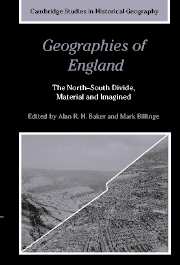Book contents
- Frontmatter
- Contents
- List of figures
- List of tables
- List of contributors
- Preface
- 1 Material and imagined geographies of England
- 2 The contemporary debate over the North–South divide: images and realities of regional inequality in late-twentieth-century Britain
- 3 Distressed times and areas: poverty, polarisation and politics in England, 1918–1971
- 4 Industry and identity: the North–South divide and the geography of belonging, 1830–1918
- 5 Divided by a common language: North and South, 1750–1830
- 6 South, North and nation: regional differences and consciousness in an integrating realm, 1550–1750
- 7 North–South dichotomies, 1066–1550
- 8 Cultural constructions of England's geography and history
- References
- Index
- Cambridge Studies in Historical Geography
5 - Divided by a common language: North and South, 1750–1830
Published online by Cambridge University Press: 10 December 2009
- Frontmatter
- Contents
- List of figures
- List of tables
- List of contributors
- Preface
- 1 Material and imagined geographies of England
- 2 The contemporary debate over the North–South divide: images and realities of regional inequality in late-twentieth-century Britain
- 3 Distressed times and areas: poverty, polarisation and politics in England, 1918–1971
- 4 Industry and identity: the North–South divide and the geography of belonging, 1830–1918
- 5 Divided by a common language: North and South, 1750–1830
- 6 South, North and nation: regional differences and consciousness in an integrating realm, 1550–1750
- 7 North–South dichotomies, 1066–1550
- 8 Cultural constructions of England's geography and history
- References
- Index
- Cambridge Studies in Historical Geography
Summary
Chalk and cheese
In 1755, two years before Clive finally secured Bengal for the Crown and four years before Sir Edmund Halley perceived pattern in a comet, Dr Johnson published the ‘first’ English dictionary. It was a defining moment in every sense: not, of course, that it was simply a matter of words. The Dictionary of the English Language also contained an English Grammar together with a rudimentary History of the English Language and, taken together, they surely spoke of a wider intent. Johnson's project – which enjoyed significant patronage – was no less than an attempt to moderate a language and, through it, to establish a culture: a terminological pretext for a national biography (Winchester 1998). So, as soldiery and science reached out to place England in its widest context, lexicography reached in: to regulate Englishness and to calibrate its nature. Yet, even as Dr Johnson searched for this common key to a common history, obvious questions arose: by whom was this language spoken and (precisely) whose history did it express? Words and their pronunciation: standard, received, dialect, colloquial, foreign or archaic are indicative not of commonality, but of difference; of the specific not the generic; and once defined in their difference, different they remain: chalk is not cheese, just as sense is not sensibility [the latter is, of course, the title of Jane Austen's novel (1811). I use it precisely because linguistic sport of this kind was much enjoyed in the late-eighteenth century].
- Type
- Chapter
- Information
- Geographies of EnglandThe North-South Divide, Material and Imagined, pp. 88 - 111Publisher: Cambridge University PressPrint publication year: 2004
Accessibility information
- 2
- Cited by

